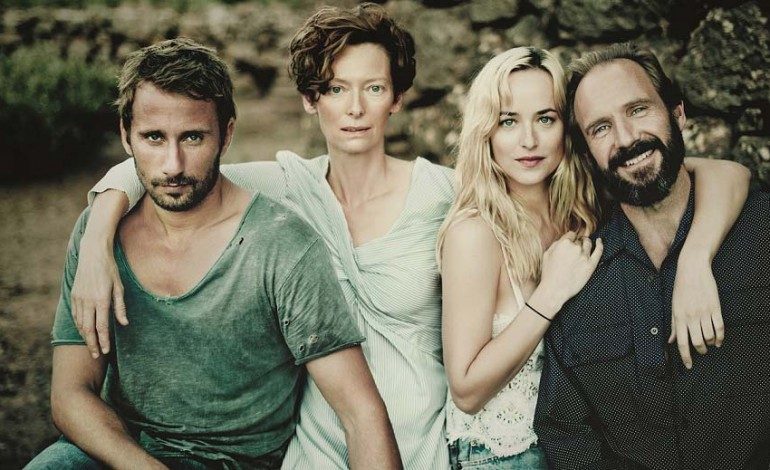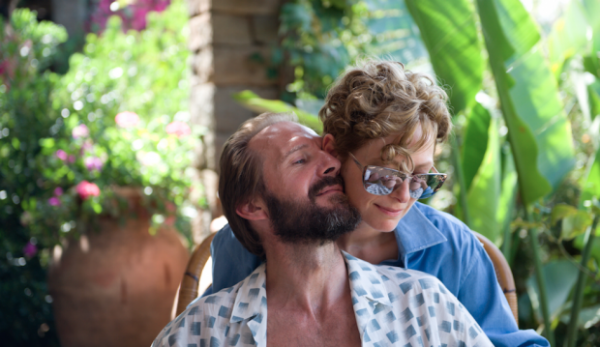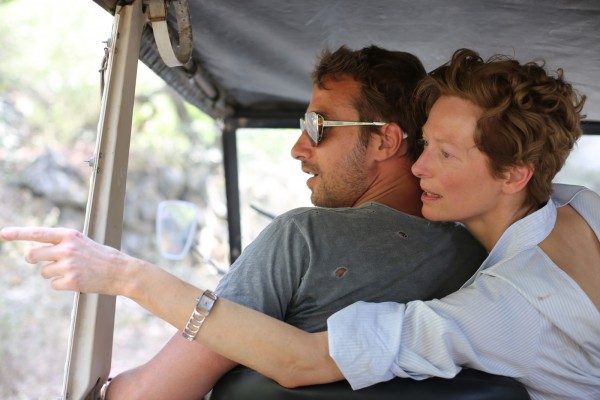

To begin, I would like to extend a giant and open-armed welcome to Italian director Luca Guadagnino, a filmmaker in a creative league of his own. Primarily creating short and documentary projects up until this point, A Bigger Splash is Guadagnino’s English language feature debut, and to put it simply, is an artistic and creative triumph. Telling a story that centers on pushing boundaries of all kinds – of emotions, sex, behavior, substances, etc. – the director himself pushes the boundaries of filmmaking and storytelling through visuals, plot, score, and character, simultaneously establishing a think piece on the human battle waged between chaos and control.
A Bigger Splash, written by David Kajganich (True Story), tells the story of a musician and her filmmaker boyfriend whose Italian vacation is interrupted by an outlandish friend from their past with his daughter in tow. The foursome recklessly unwinds in a secluded setting while blurring the lines of their various relationships. It is a tale about love, passion, jealousy, desire, and the unmitigated and uncontrollable emotions that plague the human condition.
One of Guadagnino’s muses, Tilda Swinton (Snowpiercer), plays Marianne Lane, a folky-glam rock star highly reminiscent of David Bowie. She arrives to the Italian island on vocal rest and spends the majority of the film acting through body language and a series of whispers. Her lover Paul, a recovering addict and quiet filmmaker, is played by Belgian actor Matthias Schoenaerts (Far From the Madding Crowd). Their wildly eccentric friend (Marianne’s former lover and Paul’s former confidant), Harry, is portrayed by Ralph Fiennes (The Grand Budapest Hotel) in a no-holds-barred performance, while Dakota Johnson (Fifty Shades of Grey) plays Penelope, the daughter whom he has known for a single year and whose subtle interventions shake the fabric of the vacationing group. Harry is there to deviously win Marianne back and Penelope is there to see it all crumble for what seems to be her own amusement.
Aside from the stylings of four tremendous actors, the story of A Bigger Splash is primarily told through sights and sounds. With the generous help of French cinematographer Yorick Le Saux (Clouds of Sils Maria), the film’s visual perspective possesses a deliberate unruliness. The camera swiftly cuts from sweeping wide shots to intimate close-ups within split seconds and creates the sense that the perspectives are conceived solely through the energy of the scenes and the feelings of their performers. Never before have I seen a film that so faithfully captures the feeling of a moment so completely through its camerawork. The camera also moves in conjunction with the wildness of the untouched nature and island weather. The setting thereby has nearly as much power over the story as the characters, the plot, or its framing.
The film pairs its intricate visuals with a similarly unique and purposefully disjointed soundtrack. Songs from The Rolling Stones (Harry being one of their former music producers) and similar artists are splattered throughout the film only to be oddly accompanied by varying orchestral pieces. The English rock music adds frivolity (sometimes to would-be serious situations) while melodic orchestral tunes create high drama in several otherwise ordinary scenes. The rest of the film is sonically told through silences. For a film largely about two musicians, this is particularly fascinating. Marianne being temporarily handicapped of her voice leaves her often unable to effectively communicate, resulting in the need for the audience to rely on her body’s conflicting emotions to tell her story. In this rocky marriage of sight and sound, both the framing of each shot and the sounds layered over it challenge the audience in their analytical understanding of the tones and human emotions being conveyed.
Not only does the film challenge the role of the viewer, but also that of the filmmaker and his or her subjects. In a study of chaos and control, Guadagnino uses his unconventional framing of each scene to establish its tone. On the other hand, the characters and the actors playing them live and perform with utmost abandon. The performances are so uninhibited that a clever tug of war seems to occur between the subjects of the film and the camera’s perspective. Additionally, these characters also stand in as allegorical representations of the struggle between these polar forces. Marianne, with her silenced voice and free spirit, stands for controlled chaos. Paul, who is struggling with his addiction and desperately trying to keep it together, represents chaotic control. Harry, the very definition of a free spirit, is the embodiment of chaos, while the mysterious Penelope is an unnerving incarnation of pure control. Adding these to a complex web of similarly warring creative elements, neither chaos nor control clearly comes out the victor, making for a truly wild ride.
Verdict: 5 out of 5
Guadagnino and his terrific creative team have built what I believe to be an artistic masterpiece. Every frame, though as difficult to pin down as the island wind, is planned and executed with incredible accuracy. Swinton, Fiennes, Schoenaerts, and Johnson each electrify the screen with uniquely attention-grabbing performances. The story is told richly through layered motifs that manifest flawlessly as an integral part of Guadagnino’s visuals. Every creative element reveals new depths of meaning and ultimately creates an entirely satisfying and intrinsically unprecedented sensory experience.




